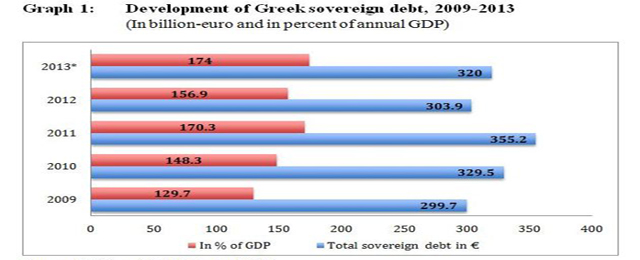Prior to the conclusion of the first economic adjustment programme more than 85 percent of Greece’s sovereign debt was held by private institutions. By contrast, following the twin debt restructuring and buyback exercise during 2012 over 80 percent of Greece’s sovereign debt now rests in the portfolio’s and budgets of the eurozone’s member states, the ECB’s and the IMF’s vaults as well as on the balance sheet of the European Stability Mechanism (ESM).
Turning the profile of Greece’s creditors entirely on its head has major implications for the political economy of the country’s debt overhang. This “drastic case of “credit migration” from the private into official hands” (Zettelmeyer et al. 2013, p. 35) is without precedent in the history of a sovereign debt restructuring exercise.[1]
Put otherwise, while in 2010 Greek sovereign debt was primarily held by German[2], French, Italian, Swiss and Japanese banks, the combination of two rescue programmes and debt restructuring have fundamentally altered the ownership structure of and accountability for the accumulated sovereign debt of Greece from the private to the official sector. Greece’s public creditors in Europe and Washington together now own roughly 84 percent of the country’s 320 billion euros in debt.
But what are the policy implications today of the aforementioned debt migration? The momentum from the private to the official sector has now firmly put on the agenda the follow-up issue of restructuring migration, i.e. from private sector involvement to official sector participation in debt restructuring. Given Greece’s current sovereign debt dynamics (see graph 1 below) it is a matter of time until this secondary migration process becomes a top priority on the political agenda of policy makers in Washington, Brussels and Frankfurt.
Against the background of this structural transition in Greece’s sovereign debt profile one has to interpret the emerging discussions about the eventuality of a third adjustment programme and/or further debt restructuring. The first two adjustment programmes for Greece from 2010 and 2012 have a combined volume of 240 billion euro. The current programme expires in mid-2014.
*Continue reading at The Agora.
**Graph: Source: Kathimerini, Aug 28, 2013; Sovereign debt levels and percentage value for 2013 are a forecast from the Greek central bank also from end of Aug 2013.






Be the first to comment on "Debt relief or debt restructuring for Greece?"